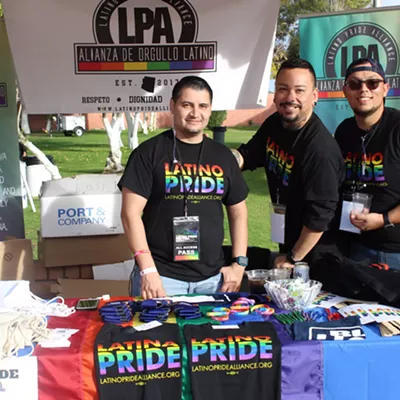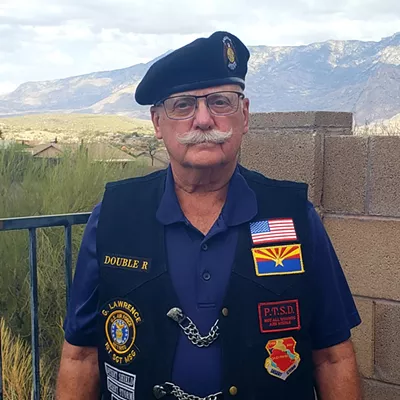Between Sanskrit chants and deep silences, people at a community sauna in the heart of the downtown Drachman neighborhood are quite chatty today, despite the loss they are about to experience.
In a backyard lot full of mesquite trees they gather together inside a 10-foot by 8-foot adobe sweat lodge for their own variety of reasons—health and healing, spiritual pursuit and community. Outside the little lodge more people than usual are in the yard.
This is not a normal Sunday for this group friends, since the property's been old—today is their last sweat on Sunday, Sept. 4.
The Drachman Sweat, referred to by most simply as The Sweat, began sometime at the end of the '70s or early '80s, depending on who you ask. Mickey Bowler, known to some as Star Lightening, recalls the first sweat on the same lot originating in a converted shed. Bowler claims he suggested the idea for a sauna after taking inspiration from his experiences in the late '70s at Healing Waters, a bygone health retreat near Safford.
Reflecting on The Sweat's beginnings and end he says, "it started out family oriented with a lot of kids here. Over time a lot of people who didn't have families (came). And yet now at this time, its very similar to the way it was in the beginning."
The Sweat a countercultural hub for nearly four decades, has served thousands of people, in search of alternatives. Taza Guthrie says her own immersion in the Tucson hippie scene in 1988, eventually landed her at The Drachman Sweat. "There was this underground network of people who traveled around the country from street fair to street fair—and a lot of those people came here," she said. "I met people here during Gem Show from all over the world."
"For this large of a place to exist for this long has been nothing but a miracle and magical. People from other groovy communities have told me they've never experienced anything like this place," she continues. "Just the fact that this place could exist: Being here in my birthday suit and knowing that 20 feet away on the other side of a wall we'd all be arrested ... It was always the litmus test for anyone new I met—are they cool enough to bring to the sweat?"
Kacey Todirita, bassist of reggae band Planet Jam who performed at The Sweat's final party, stressed the importance of such a large meeting place.
"We have a little sauna in the back of our house, but it's the size of a closet, it's nothing we can invite the community to. Socially nothing can compete and I don't know if I'll ever again see such a crew of people that just meet together in a semi public/private situation like this. It's a real blessing," she says.
Christopher Hogrelius, who's been coming for 23 years, since the birth of his first son, recalls traveling in Japan where bath culture is the norm.
"This is all hydrotherapy. A lot of nations have some variations of it, but in America we don't find it so much publicly. Really, I think its why we come here, the fire and the water open us up. And jumping in the pool, going back and forth. We're purifying ourselves, just pumping it out. It's something I fell in love with as a young person and it's been the most consistent activity in my life," he says.
Scott Stanley, a local writer and part of the community since 1999, calls it an intersection point where you meet people you eventually see all over town.
"Then you see them at the co-op, or down on Fourth Ave, or downtown. As a result I can barely go out of my house without knowing somebody," Stanley says. "And the joke is that I don't recognize people with their clothes on, but sometimes it's true."
Stanley says his first visit socializing in the buff was a little awkward, but his daughter never had time to know the difference. "My kid was nursing here, now she's coming up on five. She grew up coming here with people naked, so as a result she doesn't know she's naked yet. She doesn't know the difference between her body and her mind right now. I like that."
"It's a place where you don't feel self-conscious and my children saw this when they were young," Todirita recalls. "It's just people comfortable in their skin, not trying to hide it. That is special to see little kids running around and feeling that it's normal, because it should be."
While sweating itself can be intense, adding the communal encounter of family, friends, acquaintances, and strangers, for some, can be culture shock. Brenna Bean, a local performer and community organizer remembers her first time sweating was terrifying.
"I was a wounded person, with a lot of sorrow and fear. It took me a long time to open up and to talk to people, years. But that was the beauty of this place, that there was time to be able to open up, to open the heart," she said.
For Bean, The Sweat and its receptive company acted as a safe space that could aid her in emotional and spiritual healing, but she's not the only one.
"I can't tell you how many countless times I've been in the sweat when someone was weeping and they were allowed to weep, and in our lives we just don't give that to each other. I will never be the same. I am transformed as a human being," she says.
Bean says she feels a great loss with The Sweat's closure because she sees it as fulfilling a necessary communal connection that doesn't exist in Tucson.
"I only hope we can create something that is similar to this in spirit where we can access higher realms of spirituality without alcohol. Sometimes the superficial alcohol world is the only social outlet, but it's not healing," she says.
"We need to figure out more safe, community-oriented spaces where people can connect on a deeper level because that's what we're all craving."
Mary Whittenberg, now 60, says she's been coming to The Sweat "two years shy of half my life. Almost everyone I know I met here. And look at it, it's paradise."






